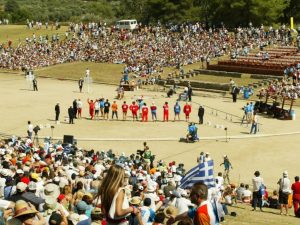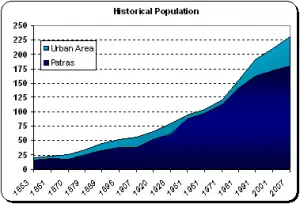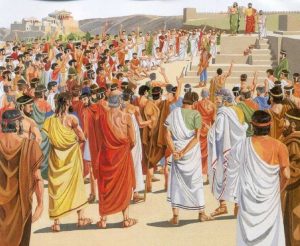Ancient Greece is considered by historians as one of the landmarks in the foundation of western civilization. Their culture and nature had a great impact on the forthcoming Roman Empire and other parts of Europe, particularly in the fields of politics, language, philosophy, arts, and education. The Renaissance of Western Europe also drew inspiration from Ancient Greece.
The geographical limits of Ancient Greece spread far beyond present Greece, into Cyprus and the Aegean islands, Anatolia, Sicily, and the southern parts of Italy. Some scattered Greek settlements were also found in the areas of the Colchis coast, Thrace, Egypt, Illyria, Taurica, and the northeast parts of the Iberian peninsula. Ancient Greek borders extended to wherever the Hellenic cultures were prevalent.
The answers to the questions of the Ancient Greek population have been periodically revisited. Estimates have suggested that Sparta and Athens were highly populated cities. They were policing jobs. People used to come to these cities to find work. There were quite many who migrated to these cities.
Ancient Sparta Population
Sparta’s ruling capacity when it was in power is unquestionable. They had a positive as well as a negative impact on the Ancient Greek population. After conquering Greece, they formed the city Sparta and bestowed it the status of the capital city.

Sparta’s significance to Greece and its population:
Sparta was located on the banks of the River Eurotas. In 10 BCE, it emerged as a significant seat of power. It soon became a place of military activity. It gradually developed into a military state. Military establishments and arsenals were set up here. Given its prominence amongst the military, Greek rulers called the shots from Sparta. During the Greek-Persian wars, Sparta overlooked matters concerning wars. Very soon, Sparta attacked Athens and emerged victorious.
Sparta was politically independent. Until the Romans conquered Greece in 146 BCE, Sparta’s independent sovereignty remained unperturbed. Sparta’s contribution to humankind is remarkable. It was here that the population of Greece rose. Sparta laid a lot of emphasis on military training. Spartan citizens, called Spartiates, had a formal military education.

Looking at the ancient Greek population of Sparta:
The estimate of the population in ancient Sparta is created using a piece of the line found in one of the retrieved manuscripts. In one such manuscript, a mention is made about eight thousand Spartan males currently available for war in Sparta. This was told by Democrats, ruler of Sparta, to the King of Persia.

This was around 480 BCE. Scientists estimated based on this calculation that at that time there were more than fifteen thousand males in all age groups. There were around seven thousand adolescent men, six thousand youth and middle-aged men, and about one thousand men above the age of fifty.
Out of this population, many were Spartans, others were Perioikoi and Helots. Perioikoi were non-Spartans freed from jails and allowed to live in the land. The Helots were owned by Spartans as serfs.
Ancient Athens Population
Athens’ significance to Greece and its population:
Athens was another historic ancient Greek city-state. It is often recognized as the birthplace of western civilization as many of the artistic ideas and classical intellect originated here. Geographically, Athens is located off the Bay of Phaleron and is bounded by the Aegean Sea and the Kifisos and Ilisos rivers flow through it. Athenian philosophy, architecture, political ideas, and literature have contributed enormously to the development of various concepts across the world.
Looking at the ancient Greek population of Athens:
The Greek city-states started to occupy the coasts of the Mediterranean and the Black Sea as colonies. But there are debates as to whether they were due to severe droughts or to gather space for the population which was getting overpopulated.
In the 5th century, the estimated Greek-speaking population in the hinterlands of the islands of the Aegean Sea vary from eight hundred thousand inhabitants to over three hundred thousand inhabitants. During the fourth century, the population of Athens was close to sixty thousand native inhabitants. But when the foreign inhabitants and the slaves are added, the population count rises to three fifty thousand to even five hundred thousand inhabitants. Out of them, around hundred and sixty thousand lived in the city while the rest of the population were confined to the suburbs and associated regions.
The Athenian population has been depicted in the works of Thucydides, the Peloponnesian War history and in the accounts of the documents from the times of the Athenian democracy. During the Peloponnesian War, even the areas in between the walls of Athens, in the Athenian city, were getting populated.
The rise and decline of population in ancient Greece:
From 800 BCE to 400 BCE, the population in Ancient Greece rose. This was due to healthy standards of living and an increase of medical inventions. It is estimated that by 400 BCE, Ancient Greece had a population of thirteen million.
It is surprising that given the sheer number of people living in those times, only little remains of their constructs. Probably, the Greeks never imagined that a future lay beyond them for humankind for more than thousands of years.
Ancient Greek population rapidly declined with the arrival of Romans. The Romans completely overturned the cultural fabric of ancient Greece, and this resulted in a decline in ancient Greece population.
Why is Ancient Greek Population low?
The general population of ancient Greece was quiet throughout the years and especially during the dark ages when the population in the Greek world became quite scarce.
The main reason for the low population was its geography in which almost 80 per cent of the land was mountainous and rough terrain. With only about 20 per cent of the land being cultivable, the amount of food produced was quite low. The agricultural yield could not support a larger number of people which left its population to be quite low.
Another reason was its harsh climatic conditions in which summers were quite harsh and rains very erratic, often bringing floods. This often led to famines and floods preventing the growth of the population.
But it became exceedingly low during the dark ages which began with the fall of the Mycenaean civilization. This phase was marked by invasions, loss of trade, droughts, famines, etc. Which made life quite difficult in ancient Greece. The urban culture went into an overall decline and even its population, making people live a semi-nomadic life in search of fertile pastures.
Population transitions and eventual collapse:
The Mesolithic population of Ancient Greece quickly transformed into peasant societies with the introduction of agriculture and there was a rapid population expansion in the Bronze Age. There was also the development of a sophisticated population in Greece when compared to the Balkans, the place from which agriculture entered Greece. Even during 1250 BCE, the population of Greece was nearly half than that of the Balkans. With the coming of the Dark Ages, the population remained exploded and began to carry more than half of the total population of the Balkans. This was the picture in the seventh century and in the fifth century the population of the Greek archipelago further increased when compared with the Balkans. Due to Alexander’s penetration in the Orient, the overpopulated population could take refuge into Asia Minor and Persia. Anatolia (Asia Minor) continued to bear the burden of the bulk of the Ancient Greek population. It was during the Byzantine period and occupation of the Turks that the Greek population steadily declined and fell way beyond the earlier population exodus figures.
More info on- ancient Greece history, culture, gods, art